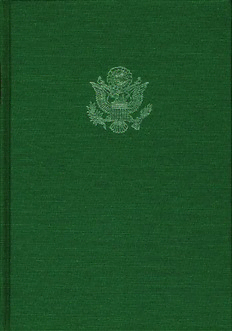
The Chemical Warfare Service - From Labratory to Field PDF
Preview The Chemical Warfare Service - From Labratory to Field
UNITED STATES ARM Y IN WORLD WAR II The Technical Services THE CHEMICAL WARFARE SERVICE: FROM LABORATORY TO FIELD by Leo P. Brophy, Wyndham D. Miles and &xmond C. Cochrane CENTER OF MILITARY HISTORY UNITED STATES ARMY WASHINGTON, D.C., 1988 Foreword Rather belatedly, the United States Army in preparing for World War II investigated on an intensive and very large scale the chemical munitions that might be necessary or useful in fighting the Axis powers. This effort required the collaboration of a host of civilian scientists and research centers as well as a great expansion of the laboratories and prov- ing grounds of the Chemical Warfare Service itself. A similar development, recounted at the beginning of this work, came too late to influence the outcome of World War I. In World War II, on the other hand, the Army not only prepared against gas warfare sufficiently well to discourage its employment by the enemy, but also developed a number of new chemical weapons that contributed materially to victory. The authors add perspective and interest to their story by telling very briefly about cor- responding German and Japanese activity. The manufacture of chemical munitions in quantity was possible only through a rapid expansion of private industry to support and supplement the work of Army arsenals. Both necessity and choice led the Chemical Warfare Service to make widespread use of small industrial concerns throughout the United States, and the account of production in this work is especially pertinent to a consideration of the problems involved in mili- tary contracting with small business on a big scale. In this and other respects, From Laboratory to Field complements other volumes in the Army series dealing with problems of military procurement. Readers generally as well as members of the Chemical Corps particularly should find it instructive. Washington, D.C. WARREN H. HOOVER 9 June 1959 Colonel, U.S.A. Acting Chief of Military History vii The Authors Dr. Leo P. Brophy holds an A.B. degree from Franklin and Marshall College and M.A. and Ph.D. degrees in history from Fordham University. After teaching history and sociology at Fordham and Seton Hall Universities, he joined the staff of the Chemical Corps Historical Office in 1945. He has specialized in ad- ministrative and logistic history. Since 1953 Dr. Brophy has served as Chief of the Chemical Corps Historical Office. He is coauthor of The Chemical Warfare Service: Organizing for War. Dr. Wyndham D. Miles has an M.S. degree in organic chemistry from The Pennsylvania State University and a Ph.D. in History of Science from Harvard. After working in industry as a research chemist, and teaching chemistry at The Pennsylvania State University, he joined the staff of the Chemical Corps His- torical Office in 1953. Dr. Rexmond C. Cochrane obtained a Ph.D. in English Literature from Columbia University and was a member of the Chemical Corps Historical Office from 1945 until 1948. After teaching at Indiana University and the University of Virginia, he returned to the Historical Office as a consultant historian. He is at present a Research Associate in the Department of History, University of Maryland. viii Preface This volume, the second in a series of three devoted to the Chemical Warfare Service (CWS) in World War II, now the Chemical Corps, covers research, development, procurement, and distribution of chemical warfare matériel. It traces the history of these activities from the World War I period, when the CWS was activated to supervise the offensive and defensive aspects of gas warfare throughout the Army, until the end of World War II. The first volume in the series, Organizing for War, dis- cusses the development of the CWS organization and mission as well as personnel management and military training. The third volume, entitled Chemicals in Combat, will deal with chemical warfare activities in the theaters of operations. In treating research and development, the present volume concentrates on CWS projects that proved of greatest significance to the armed forces during World War II. It attempts to point up the problems that arose in the course of research and development and to indicate the solutions which the scientists hit upon. Since research and development in the zone of the interior was closely related to research and development in the theaters of operations, the volume covers activities in both areas. In contrast to research and development, procurement and distribution differed considerably as between the zone of the interior and the theaters of operations; in the theaters these activities were closely associated with the commanders' combat responsibilities. The volume, therefore, confines itself to a review of procurement and distribution in the zone of the interior, leaving narration of theater activities to the forthcoming Chemicals in Combat. In World War II the CWS procured a variety of munitions and components both from government arsenals and from private industry. For some of these items the service had prepared plans in the prewar years, but for others it had not had the opportunity to make such plans. ix
